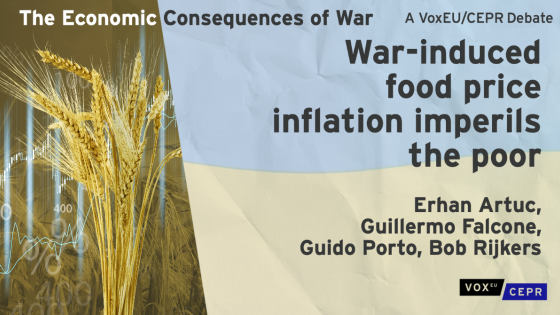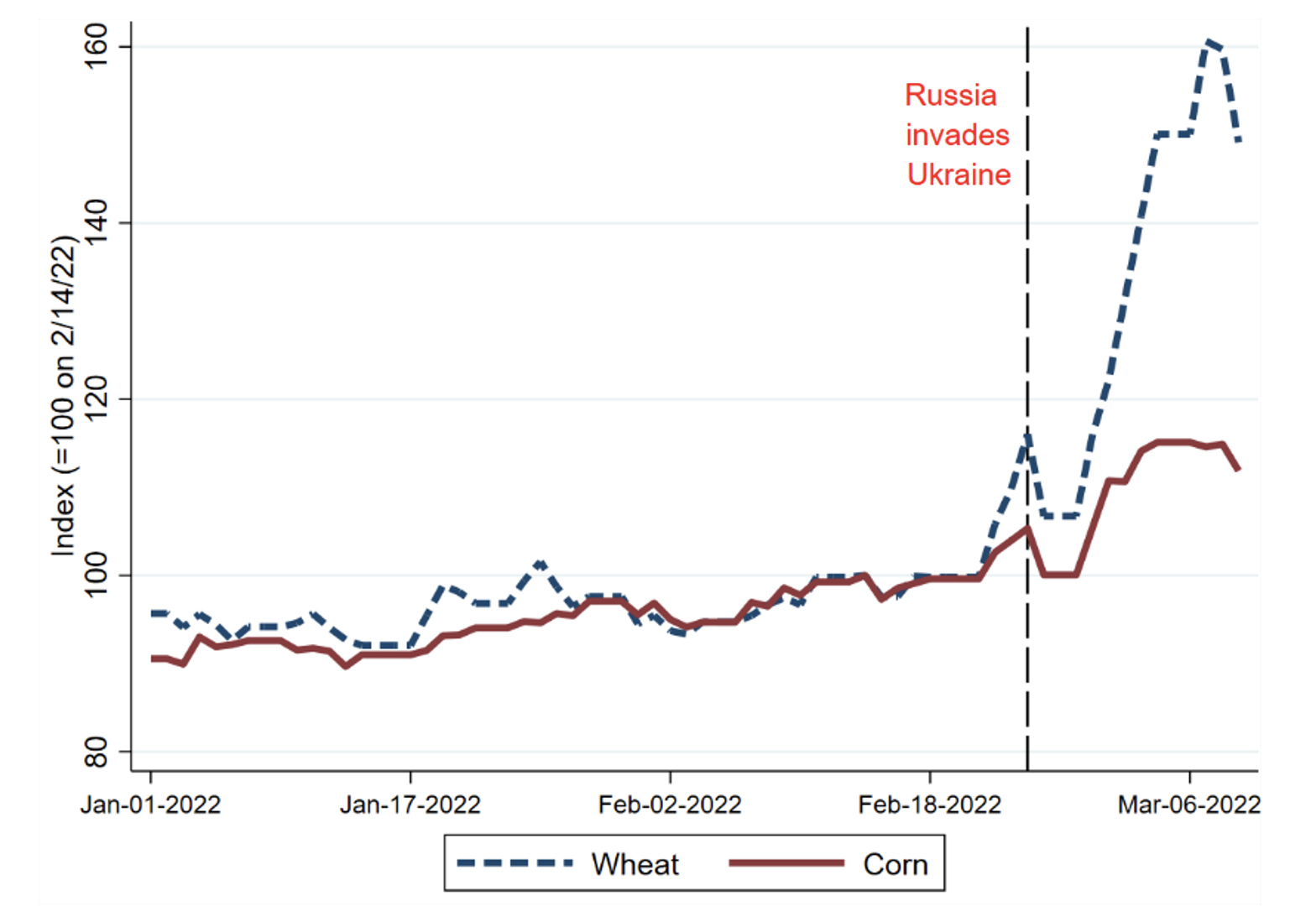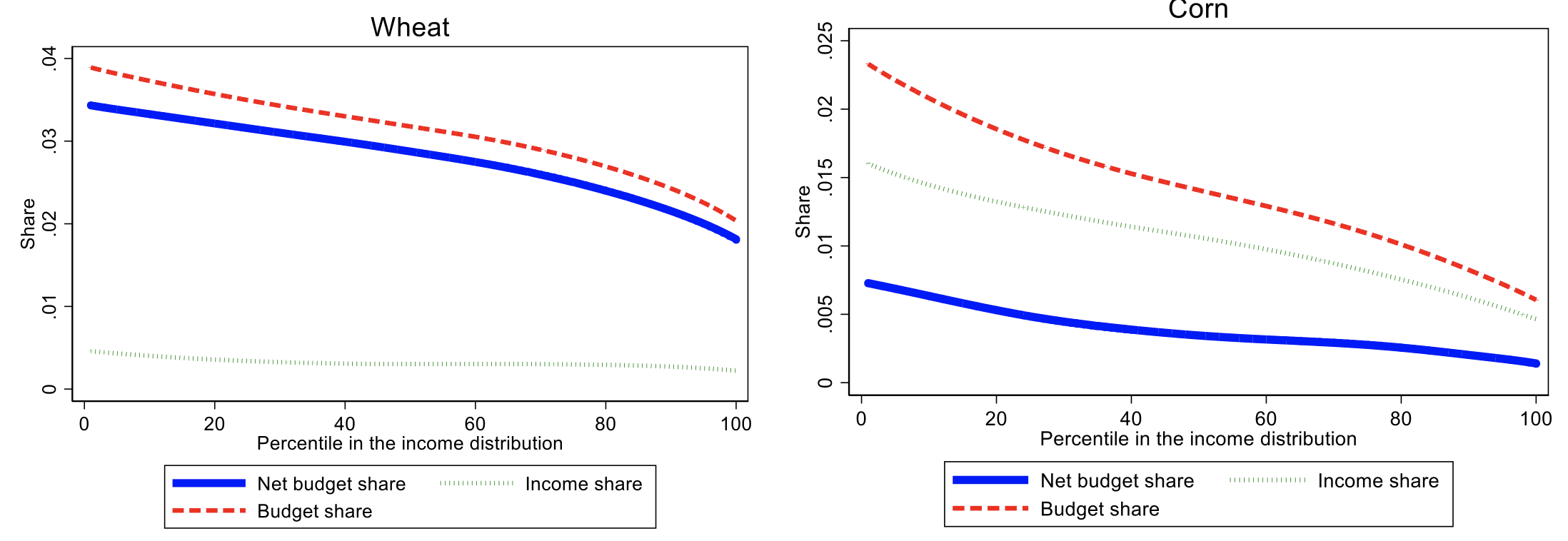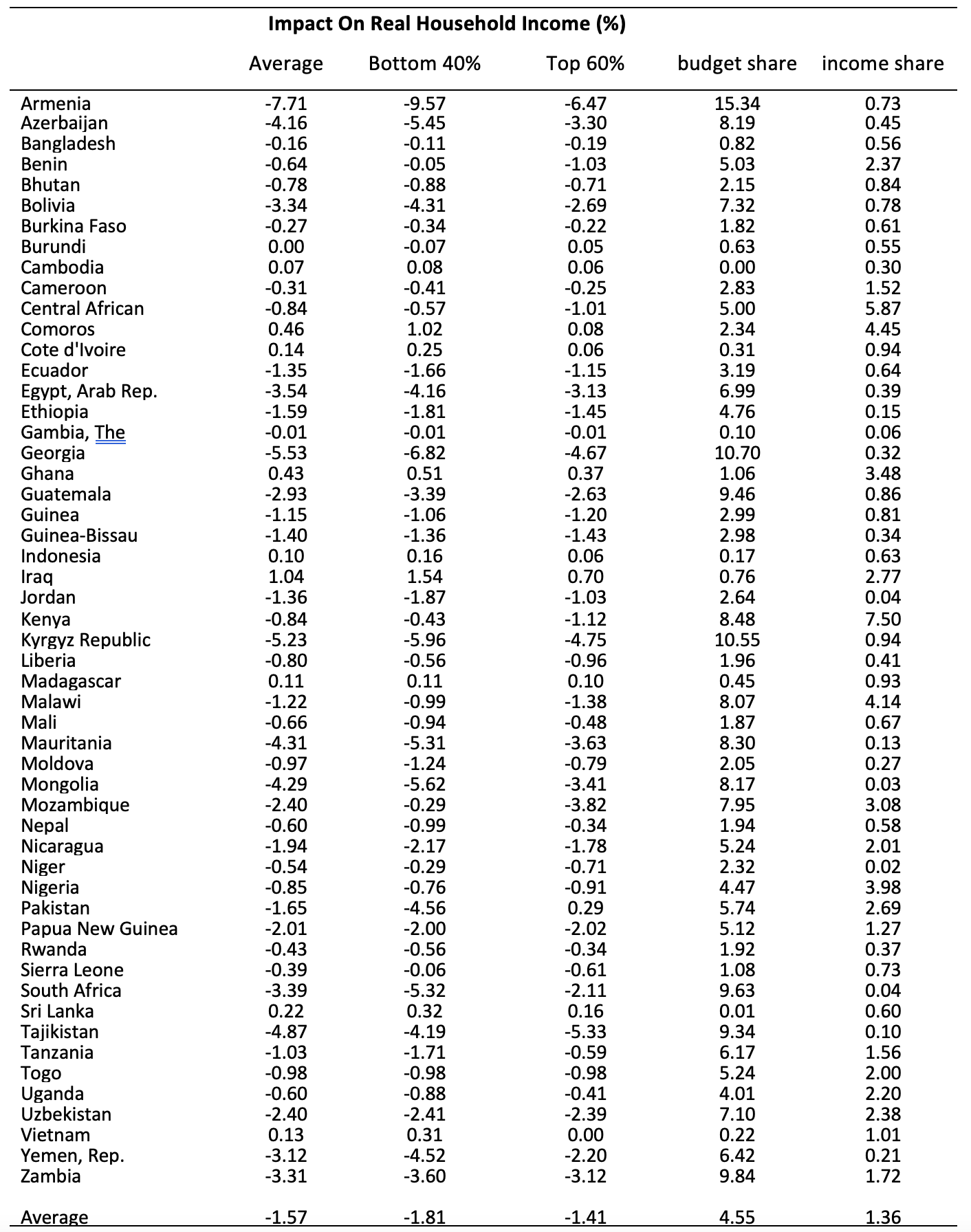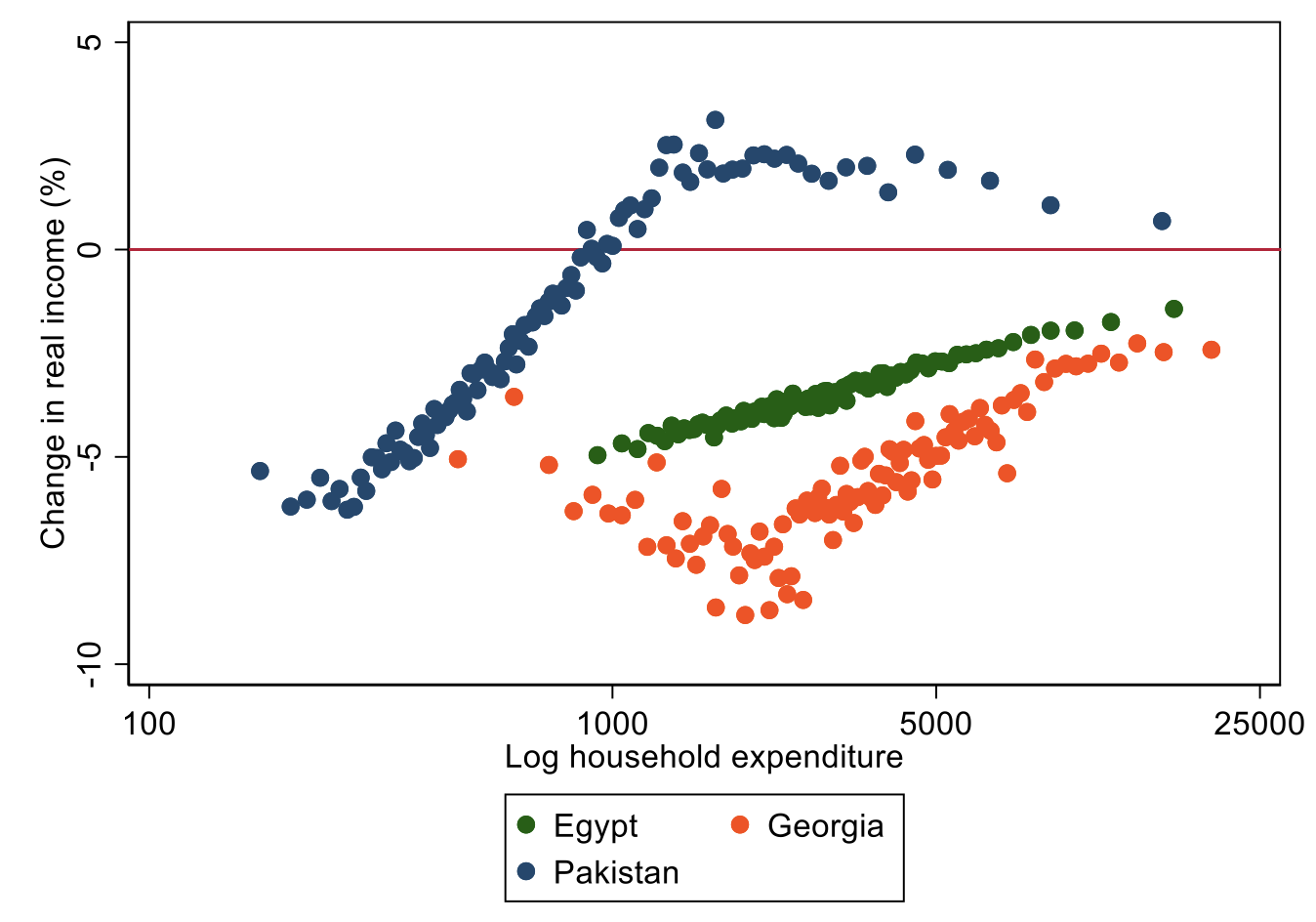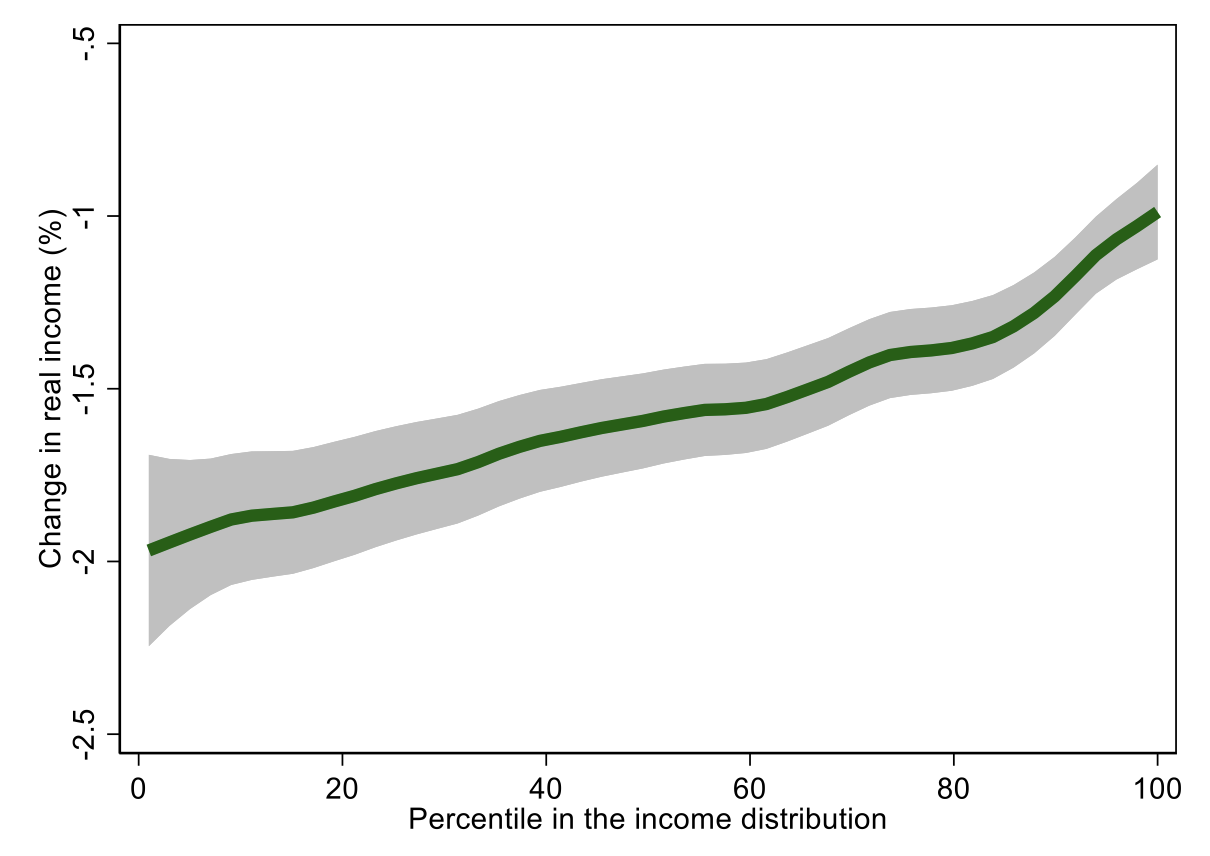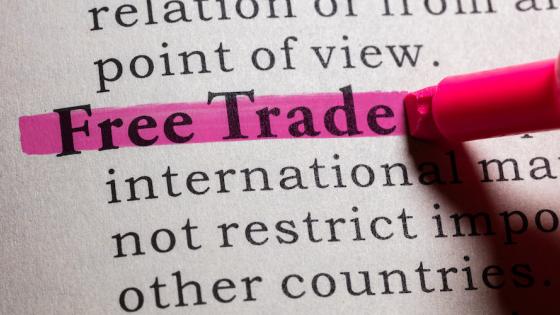Editors' note: This column is part of the Vox debate on the economic consequences of war.
The war in the Ukraine has led to a surge in global food prices (Arezki 2022) that threatens to push millions into poverty. This column presents estimates of the impact that the conflict-induced surge in wheat and corn prices is likely to have on low and lower middle-income countries. To this end, we use the Household Impacts of Tariffs (HIT) database and a new toolkit specifically designed for simulating the poverty and inequality impacts of the Ukraine war on low-income countries (Artuc et al. 2021, 2022). The HIT dataset contains household survey data from 53 low- and lower-middle-income countries, representing 1.6 billion people. The toolkit (which is available for download) has been specifically designed for the purpose of modelling the welfare impacts of food price inflation.1
Ukraine and Russia combined supply over a quarter of global wheat exports. Ukraine also accounts for 14% of global corn exports. Prices for these cereals have already soared and are expected to remain high in the foreseeable future (Selier 2022, Vaitilingam 2022). The average daily price of wheat was 53% higher during the first week of March than it was during January, while the price of corn was 23% higher. Future contracts suggest wheat prices in April will be approximately 40% higher than in January, with corn prices projected to be 24% above their January levels.
Figure 1 Wheat and corn prices surge in response to the conflict
Source: S&P Global Market Intelligence
How will these food price increases impact households in developing countries? Consumers will be hurt due to higher prices, but wheat and corn sellers will benefit. The end result depends on whether the household is a net buyer or a net seller of these food items: net consumers will lose while net producers will gain. The overwhelming majority of households (79.1%) in developing countries are net buyers of both wheat and corn. On average, across the 53 countries in the HIT dataset households spend 3.1% of their income on wheat but earn only 0.4% from wheat sales. The average corn expenditure share is 1.4%, while the average corn income share is about 1.0%. This pattern is exacerbated at the left tail of the income distribution: poorer households tend to spend a larger share of their budget on wheat and corn. This is shown in Figure 2, which plots the average share of income spent on – and derived from – wheat and corn, respectively, against households’ rank in their national income distribution. Poorer households are thus systematically more exposed to food price inflation.
Figure 2 Poorer households spend a greater share of their (net) budget on food items
We utilise our simulation toolkit to quantify the welfare impacts of the war-induced food price changes. For the purposes of this column, the household welfare metric is household real income (Deaton 1989, Artuc et al. 2019). The estimates presented here assume that the price increases observed between January and the first week of March can be fully attributed to the Ukraine war and, also, that these price hikes are fully transmitted onto domestic prices. We begin with a short-run analysis that exploits corn and wheat expenditure and income shares to calculate household real income changes. This short-run analysis assumes away any adjustment to consumption and income generating behaviours and thus provides an on-impact quantification of the real income effects of the conflict.
The resulting estimates for all 53 countries are presented in Table 1. Average household welfare decreases in 43 countries out of 53 in the sample due to higher wheat and corn prices. The average loss in household real income is -1.5%, but there is enormous worldwide heterogeneity. Countries with the largest losses are Armenia, Georgia, Kyrgyzstan, and Tajikistan, where real household incomes could fall by over 5% on average. A few countries that are not highly reliant on wheat and corn imports are hardly affected or may even gain if they are net suppliers of these commodities.
Importantly, there is a lot of heterogeneity in impacts within countries, with poor households typically bearing the brunt of the shock. Figure 3 shows how the estimated real income effects vary across the status quo income distribution in Egypt, Georgia, and Pakistan. Each dot represents a percentile of the income distribution. In Egypt, it is the poor who suffer the largest losses. In Georgia, it is the middle-income households who do. In Pakistan, poor households suffer while relatively richer households are projected to enjoy real income gains. In all three countries, food price increases are likely to exacerbate inequality, with the bottom 40% suffering systematically higher losses. Impact heterogeneity is prevalent in our sample.
Table 1 Estimated impacts of wheat and corn price inflation on real household income
Figure 3 Welfare impacts in selected countries
This pattern of income dis-equalising food price inflation applies more generally. When we pool all countries and then average across percentiles, as is done in Figure 4, we can see that real income losses are larger for poorer households – which is a consequence of them spending a greater share of their incomes on food items (as was shown in Figure 2). On average, the bottom 40% on average lose -1.8% of their incomes whereas households in the top 60% are expected to see their incomes reduced by -1.4%. Again, there is heterogeneity across countries, with 23 countries experiencing a reduction in the real income gap between the top 60% and the bottom 40%. By contrast, Pakistan, South Africa, and Armenia experience the greatest increases in inequality (see Table 1); in these countries the real income discrepancy between the bottom 40% and the top 60% increases by more than 3%. Poverty rates, measured at using national poverty lines, go up by one percentage point on average across countries.
Figure 4 Welfare impacts across 53 developing countries
To explore longer-run impacts, we assume that the price changes persist and we take into consideration that households are likely to adjust their consumption patterns as well as income-generating activities in response to changing prices. The long-run analysis conducted with our simulation tool shows that the welfare losses will persist in 31 countries, even after taking these household responses into account. Simulations also reveal that the deterioration in shared prosperity will be protracted in 29 countries if the price increase of wheat and corn persist.
The estimated welfare impacts of food price inflation are large, especially given that we have only studied two commodities – wheat and corn. But the war has also led to an increase in the costs of other food items, such as oilseeds, and energy which is likely to aggravate the burden on the poor. Direct spending on energy alone accounts for 5.4% of household expenditure in the 53 countries in our sample. Our estimates thus almost surely underestimate the aggregate welfare effects of the conflict. At the same time, we have assumed perfect pass-through of international prices to consumers and no remedial action by governments to soften the shock.
Although the exact magnitude of the impacts of the war remains uncertain, it is clear that the Ukraine war is already having significant adverse spillovers on developing countries, the burden of which is predominantly shouldered by the poor.
References
Arezki, R (2022), “War in Ukraine, impact in Africa. The effect of soaring energy and food prices”, VoxEU.org, 17 March.
Artuc, E, G Porto and B Rijkers (2019), “Trading Off the Income Gains and the Inequality Costs of Trade Policy”, Journal of International Economics 120: 1-178.
Artuc, E, G Porto and B Rijkers (2020), “Inequality and trade: Simulation evidence for 54 developing nations”, VoxEU.org, 6 January.
Artuc, E, G Porto and B Rijkers (2021), “Household Impacts of Tariffs: Data and Results from Agricultural Trade Protection”, World Bank Economic Review 35(3): 563-585.
Artuc, E, G Porto and B Rijkers (2022), “World Bank Trade, Poverty and Inequality Simulation Tool”.
Deaton, A (1989), “Rice Prices and Income Distribution in Thailand: a Non-parametric Analysis”, Economic Journal 99 (Supplement): 1–37.
Selier, P (2022), “The Ukraine war has raised long-term inflation expectations”, VoxEU.org, 12 March.
Vaitilingam, R (2022), “Economic consequences of Russia’s invasion of Ukraine: Views of leading economists”, VoxEU.org, 10 March.
Endnotes
1 https://www.worldbank.org/en/research/brief/hit
